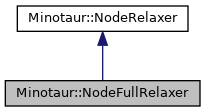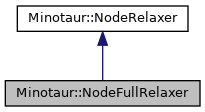#include <NodeFullRelaxer.h>


Public Member Functions | |
| NodeFullRelaxer (EnvPtr env, HandlerVector handlers) | |
| Default constructor. | |
| NodeFullRelaxer (EnvPtr env, EnginePtr e, HandlerVector handlers) | |
| If you know the engine, you can initialize it here. | |
| ~NodeFullRelaxer () | |
| Destroy. | |
| RelaxationPtr | createRootRelaxation (NodePtr root, SolutionPool *sp, bool &prune) |
| Create the root node relaxation. | |
| RelaxationPtr | createNodeRelaxation (NodePtr node, bool dived, bool &prune) |
| void | reset (NodePtr node, bool diving) |
| void | setEngine (EnginePtr e) |
| RelaxationPtr | getRelaxation () |
| void | setRelaxation (RelaxationPtr rel) |
| Set your own relaxation pointer. | |
 Public Member Functions inherited from Minotaur::NodeRelaxer Public Member Functions inherited from Minotaur::NodeRelaxer | |
| NodeRelaxer () | |
| Default constructor. | |
| virtual | ~NodeRelaxer () |
| Destroy. | |
Detailed Description
The root relaxation is stored as rel_. In each node, we apply all modifications stored in each ancestor of the node. When we are done processing the node, we undo all these changes.
If we dive after processing a node, we do not need to undo all changes and apply them again. We just apply the modifications of the parent.
Member Function Documentation
◆ createNodeRelaxation()
|
virtual |
Create a relaxation for the current node. Relaxation can be an incremental change to an existing relaxation or it can be a new relaxation created from scratch.
- Parameters
-
[in] node the node for which relaxation is created [in] dived is true if we dived down from the previous node, i.e. if this node is processed right after its parent. [out] prune is true if the node was found to be infeasible after creating the relaxation.
Implements Minotaur::NodeRelaxer.
◆ createRootRelaxation()
|
virtual |
Create the root node relaxation.
- Parameters
-
[in] rootNode A pointer to root node. [out] prune is true if the root node can be pruned, either because the relaxation is found to be infeasible or because a trivial solution has been found.
- Returns
- a pointer to the relaxation. The method must create a relaxation even if we want to prune the root node.
Implements Minotaur::NodeRelaxer.
◆ getRelaxation()
|
virtual |
Return a pointer to the last relaxation that was created by this relaxer.
Implements Minotaur::NodeRelaxer.
◆ reset()
|
virtual |
After processing the node, some node relaxers may like to make changes. This function is the place to do it. diving is true if the next node to be processed is a child node of the current node.
Implements Minotaur::NodeRelaxer.
◆ setEngine()
| void NodeFullRelaxer::setEngine | ( | EnginePtr | e | ) |
Set the engine that is used to solve the relaxations. We need to set it in order to be able to load warm-starts at a node.
The documentation for this class was generated from the following files:
- /home/amahajan/tmp/minotaur-test/src/base/NodeFullRelaxer.h
- /home/amahajan/tmp/minotaur-test/src/base/NodeFullRelaxer.cpp